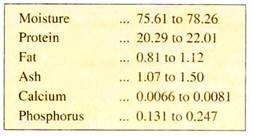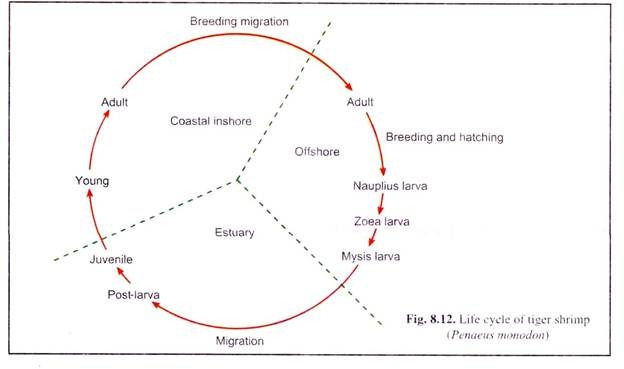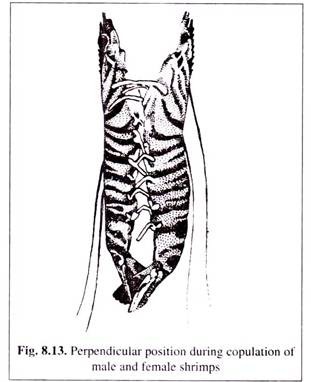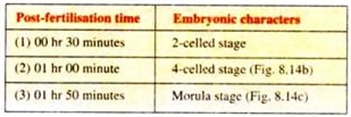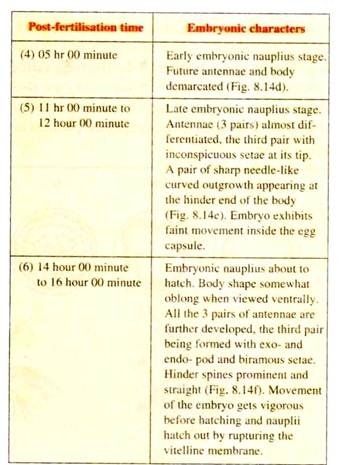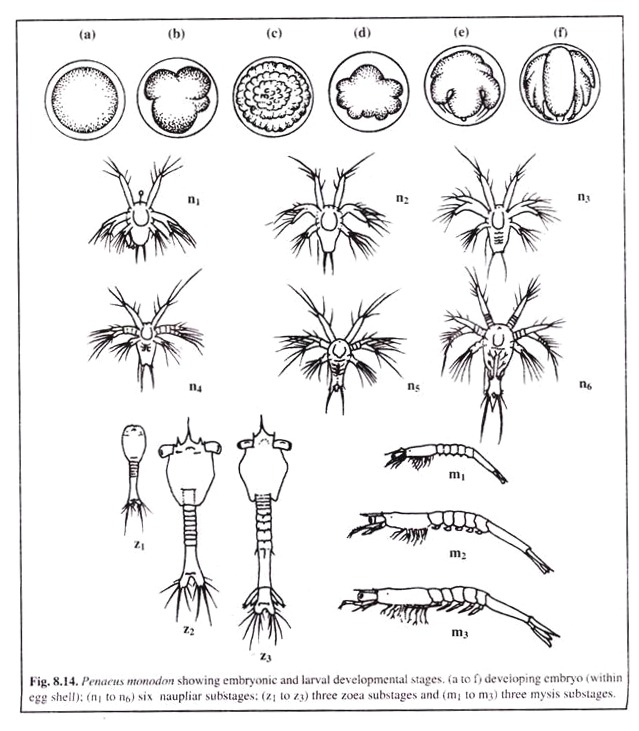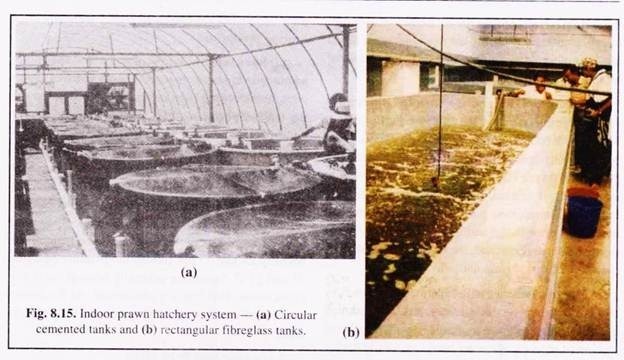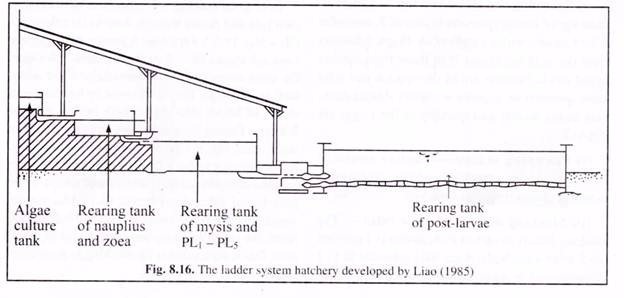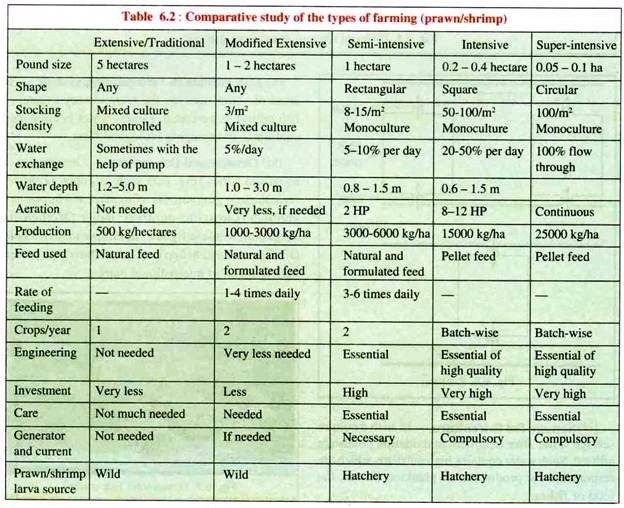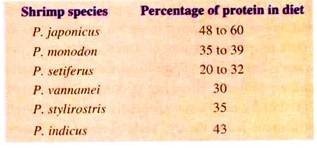In this article you will learn about the Tiger Shrimp (P. Monodon):- 1. Introduction to Tiger Shrimp 2. Biochemical Composition of Tiger Shrimp 3. Distribution, Habit and Habitat 4. Biology and Life History 5. Culture Practices 6. Harvesting and Marketing 7. Diseases.
Introduction to Tiger Shrimp:
The tiger shrimp (Fig. 8.11), Penaeus monodon, forms both capture and culture fisheries of commercial importance.
It is the fastest growing species used in aquaculture with major potentiality in India, Bangladesh and a few other countries. P. monodon is euryhaline and can tolerate nearly freshwater conditions, although 10-25 ppt salinity is considered optimum. It can tolerate a temperature between 12°C and 37.5°C.
ADVERTISEMENTS:
Apart from P. monodon, other commercially farmed shrimps are P.japonicus [Fig. 8.3(d)], P. indicus [Fig. 8.3(a)], P. merguiensis [Fig. 8.3(b)] and P. vannamei [Fig. 8.3(e)]. Although considerable similarities in the culture technology is present for these species, there are also a number of differences. These differences are due to environmental requirements, breeding, feeding behaviour and compatibility with other species.
However, P. monodon is the most extensively cultivated shrimp among the 29 recorded penaeids because it is best suited for culture in confinements, attainment of large size, faster growth, hardy nature, greater tolerance to varying salinity, temperature and oxygen, natural abundance of seed and high market price with large export potentiality.
Research on shrimp culture has been in line with development in hatchery techniques for induced breeding, controlled spawning and larval rearing.
Biochemical Composition of Tiger Shrimp:
Biochemical composition (%) of adult tiger shrimp constitutes of the following:
Distribution, Habit and Habitat of Tiger Shrimp:
In India, the natural distribution of tiger prawn is along the east and west coasts with high potentiality in the Sunderbans covering an area of about 16,900 km2 at the Gangetic delta and also Chilika Lake.
Habit and Habitat:
Mainly marine in habitat and bottom dweller. It is present in inshore and offshore regions of varying depth (0 to 72 fathoms). Tiger prawn can invade and thrive well, both in brakish water and freshwater rivers, rivulets, paddy-fields and other impoundments for its great migratory behaviour and highly efficient hypersomatic regulatory system in adjustment with low saline water.
Biology and Life History Tiger Shrimp:
The life cycle of tiger shrimp, P. monodon, is summarised in Figure 8.12.
(a) Food and Feeding Habits:
P. monodon in its larval, juvenile and adult stages shows various food preferences. Zoea and mysis stages are phytoplankton feeders, mainly consuming diatoms. For post-larva and juvenile, periphyta form the main food.
ADVERTISEMENTS:
Adults, on the other hand, prefers animal matter like polychaetes, crustaceans, insects, small molluscs, ophiuroids, fish remains, etc. During scarcity of food and overcrowding, adult prawns show cannibalistic tendency, preying mainly upon the moulted and weaker ones.
(b) Growth and Maturity:
Tiger shrimps have faster growth rate. Males attain sexual maturity at minimum size of 31 mm or 20 gm in pond environment and 37 mm or 35 gm in wild.
In case of females, sexual maturity is attained at 41 mm or 40 gm in pond and 46 mm or 63 gm in the wild environment. In deep sea, the natural abode of tiger shrimp, the likely environmental factors that stimulate sexual maturity are high water pressure, darkness, low temperature and high salinity.
Under rearing condition of pond environment with nutritious rational feeding and judicial water management, maturity of tiger shrimp can also be attained. Maturation can be quickened with favourable range of temperature (27.75-30.55°C) and salinity (24-31 ppt). Maturation can also be achieved artificially through eye-stalk ablation.
(c) Pre-Spawning Moult and Mating:
The pre-requisite for mating in P. monodon is the moulting of the female, since it is a ‘closed thelycum’ shrimp. Mating, thus takes place between three hard-shelled males and a newly moulted female.
The males insert spermatophore into the female thelycum (Fig. 8.2b) by the appendix masculina (Fig. 8.6b). During mating the male positions itself directly below the female. The pair engages in parallel swimming movements and then quickly shifts to perpendicular position (Fig. 8.13).
In nature, mating of tiger shrimp takes place in the sea (in more saline areas), where the spawners and milters migrate from the estuary or brackish water areas. Complete darkness as well as bright flood light can hinder mating.
(d) Fecundity:
ADVERTISEMENTS:
In P. monodon fecundity range largely varies. It depends upon the varying body size, condition of the spawning female, uneven development of the ovaries in the same age group and so on. Variation in egg number is also seen in wild and captive ablated females.
A wild spawner of size 150-200 gm may produce more than a million eggs, while an ablated artificially matured female may produce 3.55 lakh eggs under confinement. Hatching rate varies from 0 to > 90% depending on maturation, sex ratio, spawner size, type of ablation (unilateral/bilateral), mating efficiency, water depth and other physiological factors.
(e) Spawning:
Spawning in tiger shrimp takes place in late night or early morning in relatively deeper water and preferably near river mouths. High salinity of the sea is required for larval development.
Spawning season spans throughout the year and varies from region to region depending upon the environmental conditions. In Indian environment breeding takes place in almost all the months of the year, with different peaks at different coastal areas. In West Bengal it is during April/May and October/ November, while in Orissa it is November-February.
(f) Embryonic Development:
Cell division of fertilised egg in P. monodon [Fig. 8.14 (a-f)] commences about half an hour after spawning. Incubation period is 12-16 hours at 27°C to 29°C.
Embryonic development is very simple and its salient features are given below:
(g) Larval Development:
Larval development in tiger shrimp is a complex and a much elaborate process, passing through several metamorphoses to attain the adult form. The hatchings have to pass through 6 nauplii, 3 zoea and 3 mysis stages to attain post-larval stage. The changeover from one stage to another takes place after a moult and finally results into the post-larva or megalopa larva.
The four larval stages (nauplius, zoea, mysis and megalopa) take about 10-15 days. In nature, the development of egg to mysis stage (Fig. 8.14) occur in the outer littoral zone of the sea. The megalopa larva undergoes development while migrating through the inner littoral zone and estuarine area.
(h) Nauplius Larva:
The six naupliar stages [Fig. 8.14 (n1 to n6)] each followed by a moult, vary in length ranging from 0.32 mm to 0.53 mm and the duration of development varies between 48 and 53 hours. The naupliar stages exhibit planktonic behaviour and subsists on the small embryonic yolk. It has three pairs of antennae, the first pair uniramous and the second and third biramous.
(ii) Zoea Larva:
The three zoea stages [Fig. 8.14 (z1 to z3)] have size length measuring from 1.02 mm to 2.75 mm and the duration of development varies between 120 to 144 hours or 5 days. They are also planktonic in behaviour and with their relatively increased sized mouth it can accept food particles as big as 50 μm in size.
(iii) Mysis Larva:
The three mysis stages [Fig. 8.14 (m1 to m3)] have their length varying between 3.40 mm and 4.37 mm. Their duration of development varies from 288 to 341 hours, depending upon the temperature of water and the feeding components. Mouth large and can accept food of sizes up to 200 μm.
(iv) Megalopa Larva:
This is generally called as the post-larvae measuring from 5 to 20 mm in length. The first post-larvae measures about 5 mm.
It has a transparent slender body and a dark brown streak on the mid-ventral side extending from the tip of the antenular flagellum to the tip of the telson which turns pink in smaller (6-14 mm) and then green in larger (15-20 mm) specimens. The body being transparent is not easily distinguishable from mixed collection in the net, unless transferred to a tray with a clean white background.
(v) Juveniles:
They are more than 21 mm in length with complete gill system. Body is blackish or greyish in colour. It spends its life in estuarine environment.
(vi) Adult:
Adult characters appear with sex differentiation. It lives in estuarine environment.
Culture Practices of Shrimp:
Culture of shrimp is mainly carried out in ponds, in both traditional and modern type of practices. The culture can be divided into (A) seed stock production and collection. (B) Hatchery system and (C) Grow- out system.
1. Seed Stock Production and Collection:
Seed stock production through hatchery tec hnique has not gained much importance commercially, since major shrimp-culturing countries depend mainly on the collection of post-larvae and juveniles from the natural sources.
Collection of Seed Stock from the Wild:
In traditional system of culture, post-larvae and fry are brought in by the incoming tidal water. The unwanted fish larvae and fry are eliminated from those of the shrimp by an improved system of stocking. In this improved system, the nursery ponds are filled with as many larvae and fry as possible by manipulating the tidal flow.
The pond after a month is treated with tea-seed cake (this contains 10%-15% saponin) at the rate of 10-25 ppm. This kills all the fish larvae without affecting the shrimp larvae and fry. These then are transferred to the rearing or production pond.
Fry of shrimp can also be collected with different types of lure lines and nets, such as scoop nets, fine- meshed bag nets, push nets, scissor nets, etc. The post-larvae can be identified as given earlier.
2. Hatchery Systems:
In hatchery system, controlled maturation, spawning and larval rearing of shrimps are undertaken. Initially such culture was directed towards mass production with gravid females being collected from the wild. But later, success was achieved through maturation and mating of shrimps in captivity. Here too. mature females that have undergone prenuptial moulting can be mated.
For large scale production in hatchery system, it is very difficult to obtain sufficient spawners of P. monodon from the wild. Therefore, for large scale production of adequate numbers of larvae of this tiger shrimp, maturation of captive stock, either wild- caught or pond-reared is necessary.
Further, induced breeding through unilateral eye-stalk ablation is also undertaken for P. monodon to make them spawn freely in controlled environmental condition.
(a) Shape and Size:
Hatchery tanks of various shape and size (Fig. 8.15) are in use made of cement concrete, ferrocement, plastic, fibreglass, etc. These tanks are used for spawning and larval rearing. Cages and pens have also been used but not on commercial basis.
The size of the hatchery tanks ranges between 100 and 2000 ton capacity and are suitable for spawning a large number of spawners at a time. It is also used for larval rearing and fry nursing. As all is done in the same tank, it is often referred to as the community culture method.
Contrary to it, many hatcheries developed separate smaller sized tanks made up of plastic or fibre- glass for spawning, larval rearing and culture of live food. The capacity of spawning and larval rearing tanks varies from 100 to 250 litres and 1000 to 2000 litres, respectively. In case of P. monodon where availability of spawners is difficult, community culture is not commercially efficient.
A third system of hatchery tanks is also in use, which combines the advantages of the above two types. This system maximises tank utilisation, particularly for P. monodon culture of spawning and larval rearing. This system comprises 1000-2000 litres capacity of spawning tanks; 1000-3000 litres of larval rearing tanks and 30-100 tons of nursery tanks.
Another “ladder system” hatchery, developed by Liao (1985), is also in use, comprising four interconnected tanks that are built on a sloping ground (Fig. 8.16).
At the top of the slope is the algal culture tank, followed below by the nauplii and zoea larvae rearing tank; another mysis to PL1 – PL5 stages rearing tank and finally a large post-larvae rearing tank. These four tanks are all built one below the other with descending water levels.
(b) Larval Food:
The food of larval shrimps are raised by fertilisation of the tanks to produce plankton. Among the phytoplankton, Chaetoceros, Skeletonema and Tetraselmis are preferred as food by the shrimp larvae. Among the zooplankton, Brachio- nus sp. (rotifer) is probably the most important larval food. Another important larval food is the nauplii of brine shrimp (Artemia salina).
In larger tank hatcheries, where community culture is being practised, the tanks are fertilised with 3 mg/1 of KNO3 and 0.3 mg/1 of Na2HPO4. This produces phytoplankton which are used to feed the protozoea stage.
The phytoplankton production is maintained, if needed, through further addition of fertilisers. Sometimes, pure cultures of diatoms are inoculated prior to the addition of fertilisers. When the mysis stage is reached, the larvae are fed on Bra- chionus or brine shrimp nauplii.
In case of hatcheries with separate small hatchery tanks or in ladder system hatchery, algae are cultured in separate algal tanks or in plastic bags. The required amount of phytoplankton are introduced daily during the protozoea stage. Zooplankton are also hatched in special tanks and are fed to mysis and early post- larval stages.
When the density of production of plankton becomes inadequate, supplementary feed is given in the form of soybean cake, soybean curd, fertilised eggs or egg yolks of oysters, etc. In the post-larval stage after the fifth day, they are fed on polychaetes, chopped mussels, clams, cockles or artificial compound diets, three or four times a day.
(c) Spawning and Larval Rearing:
The minimum age of female spawners in case of P. monodon is 9-15 months with a weight of 32-45 gm. Spawners from the wild are bigger than those from captive brood stock. Farmers are of the opinion that wild stock spawners are superior to captive ablated spawners as the quality and quantity of their eggs are higher.
(i) Spawning Season:
Captive stocks of P. nonodon under controlled conditions can be made to spawn almost throughout the year.
(ii) Stocking Density and Sex Ratio:
The stocking density in case of P. monodon is 1 spawner per 5 m3 of water body. A sex ratio generally of 1: 1 is maintained in spawning tanks, but a ratio of one male: 2 females has produced higher spawning rates and egg production.
(iii) Spawning:
In case of controlled spawning, advanced stages of matured gravid females (soon after their moulting) and males are stocked in spawning tanks. Spawners obtained from the wild during winter are disinfected with 3 ppm KMnO4, 25 ppm formalin or with 3-5 ppm of the commercial product, Treflan.
In community culture method, several spawners are introduced into the large tank, while in other culture systems, individual spawners or batches of spawners are introduced in separate spawning tanks.
The salinity in the tanks has to be maintained between 28 and 35 ppt and the temperature between 23 and 33°C. Spawning generally takes place in the night hours. Fertilisation is external. At the above mentioned temperature, embryonic development is rapid.
A few points are to be noted:
(1) There is generally a time lag between mating and spawning. Therefore, the eggs may not be fully matured at the time of mating.
(2) In case of P. japonicus and P. indicus, the females have a tendency to eat their own spawned eggs. So in their culture, it is advisable to install mesh trays or plates on the bottom of the spawning tanks to protect the eggs. After all the eggs have been collected, the spent females are separated.
(iv) Larval Rearing:
The nauplius subsists on its own yolk and passes through three to six sub-stages (N1 – N6). In 2-3 days time it passes through three zoea sub-stages (Z1 – Z3). During these sub-stages the larva starts feeding on unicellular algae and it lasts for 3-6 days.
This is followed by the three sub- stages of Mysis (M1– M3) which last for another 3-5 days. During these stages the larva also feeds on algal cells. Mysis then metamorphoses into post- larvae, ceases to be a filter-feeder and becomes capable of capturing and eating zooplankton.
From post-larval (Megalopa larva) PL1 – PL5 stages, development is gradual and takes about 15-20 days to reach the juvenile stage, attaining a size of 20-25 mm. This is then suitable for stocking in production ponds.
The main difficulty faced in rearing of protozoeal stage is when they start feeding, and at this stage cultured phytoplankton is the most efficient food for larvae. Also, the protozoeal larva is most sensitive to light and so the tank should be properly covered to ensure darkness.
The last sub-stage of protozoea starts feeding on zooplankton. Both mysis and post- larvae prefer zooplankton up to the fifth day, after which they consume larger food and feed at the bottom.
(v) Nursery Ponds:
Nursery ponds vary in size ranging from 500 to 2000 m2 in area with an average depth of about 40-70 cm. Larvae are stocked at the rate of 100-150 per nr. Prior to the introduction of larvae, the ponds are prepared by irradicating predators and then fertilising with a combination of organic and inorganic fertiliser.
Nursery cages may also be used which are rectangular in shape (1-2 m x 5 m x 1 m). They may be either floating or stationary type installed in protected bays, lagoons or ponds. They are stocked with larvae at higher densities of 1000-2000 per m2. However, the cages are rarely used as their small mesh sizes become rapidly choked by biofouling.
3. Grow-Out System:
The common grow-out system of shrimp culture is carried out in earthen ponds. Presently, extensive culture methods are giving way to semi-intensive methods of culture.
The traditionally cultured coastal shrimp ponds are now stocked with sorted fry collected from the wild or bought from fry collectors and stocked at a low rate of 3000-5000 fry/ha. These ponds are prepared before stocking of fry and water exchange is maintained using tidal flow during the two months of rearing period.
(a) Semi-Intensive Farming:
Modern shrimp farming is carried out following mainly semi- intensive forms of culture. Farming is done in specially designed pond farms which usually have a hatchery, nursery and rearing ponds. These ponds are generally rectangular in shape and 1-3 ha in area, having a depth of 0.8-1.2 m.
Stocking rate varies considerably from 28,000 to 50,000 fry/ha. Natural food (produced by application of fertiliser) and supplementary feed or formulated feed are given. Water exchange in large scale is required in culture ponds to accelerate and synchronise the moulting cycle of the stock. In this type of culture the yield has been found to be about 1.5-2 tons/ha per crop.
(b) Extensive Farming:
Extensive farming of shrimps in India is carried out in paddy-fields. Paddy-cum-shrimp culture has also undergone some changes due to the introduction of controlled stocking of fry and better management of water and manuring by rice stubble. Yield of about 400 kg/ha per crop has been achieved under very favourable conditions. Otherwise, the yield is around 200 kg/ha per crop.
(c) Intensive Farming:
Intensive farming of shrimps is usually carried out in cemented tanks. Smaller earthen ponds are also used of 0.5-1 ha size and 60-150 cm depth. In such impoundments, inlets and outlets are arranged in such a manner so as to effect proper circulation of water.
Aeration of the water is done with equipment’s such as paddle wheels and air blowers. Stocking is done at the rate of 200-250 fry/m2. Formulated diets comprising high protein are fed to the fry. Yield of about 1.5-3 tons per crop has been achieved and in special ponds about 28 tons/ha/year.
Super-intensive culture using high stocking density and heavy feeding often results in environmental disaster and health problems and has, therefore, been seriously criticised. A comparative study of the above farming is given in Table 6.2.
(d) Pen Culture of Shrimps:
Pen culture of shrimps has been practised in lagoons in southern India in suitable intertidal areas enclosed by net fencing. These pens are constructed at a height of 1 metre for holding water during low tide. It resembles tidal ponds and the area enclosed extends to about 10,000 m2 with a depth of 1-1.5 m. Stocking rate is between 20-30 per m2. Average yield is about 3-4 tons/ha/year.
(e) Polyculture vs Monoculture of Shrimp:
Although it is a known fact that polyculture yields higher production, still most shrimp farmers prefer monoculture of the fastest growing species of shrimp. On the contrary, shrimp culturists do resort to polyculture but it is with other shrimp species. This is done due to shortage of seed stock of the preferred species.
From economical point of view also, monoculture is found to be more profitable due to the high market value of shrimps. It has been recorded that the gross revenue per unit area of monoculture farms growing P. monodon is about double than that of polyculture farms growing the tiger shrimp along with milkfish and crabs.
(f) Food and Feeding:
The dietary requirements of different species of shrimp exhibit considerable differences, particular with regard to protein diet.
Some marine shrimps require much higher protein diet as given below:
Shrimp feeds also require sterols and fatty acids as their synthesis does not take place in the body of crustaceans. Standard remixes of vitamins and minerals are also added in all diet formulation.
In larval and fry rearing as well as in adult grow- out, fresh and live food are given. Commercial feed are rarely used as its acceptance in commercial farming is rather slow. Farmers generally use them along with natural food and feedstuffs.
Harvesting and Marketing of Tiger Shrimp:
Efficient harvesting of tiger shrimps are based on the habit and culture procedures.
The time of harvesting is based upon the following habits:
(1) Tiger shrimps are attracted by light.
(2) They graze at night.
(3) Shrimps actively respond to movements of water, particularly when water is let into or drained out of a pond.
(4) They are more active during new moon and full moon.
(5) Maximum activities are witnessed shortly after sunset and shortly before sunrise.
At the end of each crop total harvesting is conducted by draining out the water and placing a bag net at the sluice gate. The shrimps are caught as they swim out from the pond. When partial draining is done, partial harvesting is employed by seine nets.
Electric fishing is also successfully conducted in harvesting tiger shrimps in some countries, generally during cool seasons. However, harvesting should be avoided when most of the shrimps are undergoing moulting.
Marketing of live shrimps are done in containers placed in cold water tanks. For long-distance transport, shrimps are preserved by freezing following the shrimp processing procedures.
Diseases Encountered by Tiger Shrimp:
Tiger shrimp is hardy in nature. It is thermal and euryhaline. It can tolerate low concentration of dissolved oxygen as well as various stresses (environmental and infestational). Normally, adults are resistant to disease, but are highly susceptible to parasitic infections. Both infectious and non-infectious diseases are encountered which are listed in Table 8.6.

